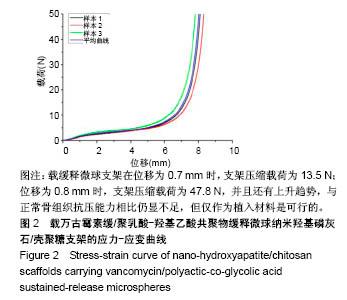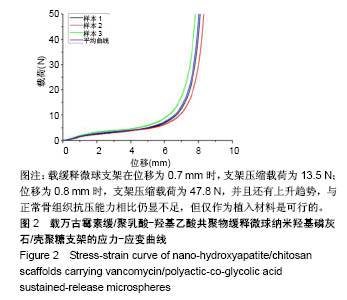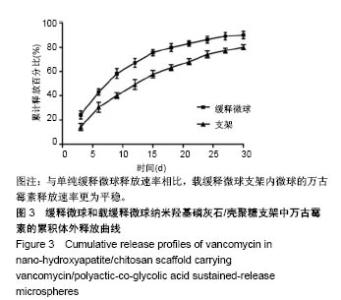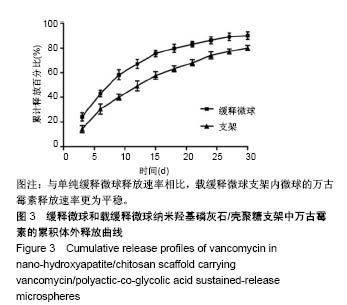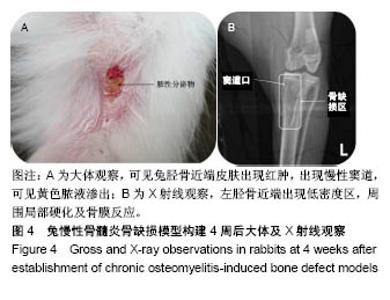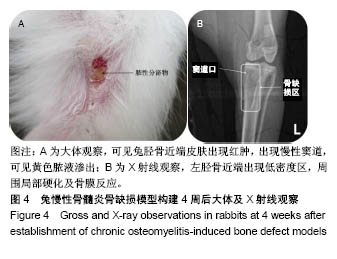Chinese Journal of Tissue Engineering Research ›› 2019, Vol. 23 ›› Issue (6): 843-848.doi: 10.3969/j.issn.2095-4344.1568
Previous Articles Next Articles
Repair of bone defects due to chronic osteomyelitis in rabbits using nano-hydroxyapatite/chitosan scaffold carrying vancomycin/polyactic-co-glycolic acid sustained-release microspheres combined with autologous red bone marrow
Xiang Bingyan, Li Peng, Bo Fan, Zhou Sirui
- the First People’s Hospital of Zunyi, Zunyi 563000, Guizhou Province, China
-
Received:2018-08-24Online:2019-02-28Published:2019-02-28 -
About author:Xiang Bingyan, MD, Associate chief physician, the First People’s Hospital of Zunyi, Zunyi 563000, Guizhou Province, China -
Supported by:the United Science and Technology Foundation of Zunyi, No. 2017(42) (to XBY)
CLC Number:
Cite this article
Xiang Bingyan, Li Peng, Bo Fan, Zhou Sirui . Repair of bone defects due to chronic osteomyelitis in rabbits using nano-hydroxyapatite/chitosan scaffold carrying vancomycin/polyactic-co-glycolic acid sustained-release microspheres combined with autologous red bone marrow[J]. Chinese Journal of Tissue Engineering Research, 2019, 23(6): 843-848.
share this article
Add to citation manager EndNote|Reference Manager|ProCite|BibTeX|RefWorks
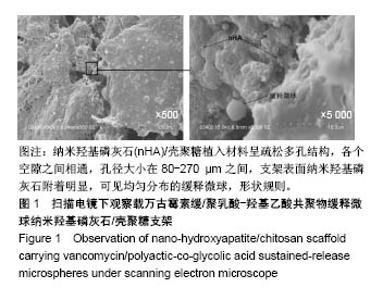
2.1 万古霉素/PLGA缓释微球的载药量和包封率 以万古霉素含量的标准曲线比对,测定微球的载药率为(5.24±0.35)%,包封率为(48.51±12.14)%。表明此法所制备缓释微球万古霉素含量较高,且丢失率较低。 2.2 载万古霉素缓/PLGA缓释微球支架的表征 通过扫描电镜观察到纳米羟基磷灰石/壳聚糖植入材料呈疏松多孔结构,各个空隙之间相通,孔径大小为在80-270 μm之间,平均孔径为(146.53±22.43) μm,支架表面纳米羟基磷灰石附着明显,可见均匀分布的缓释微球,形状规则,见图1;生物力学测试结果中平均曲线显示,载缓释微球支架在位移为0.7 mm时,支架压缩载荷为13.5 N;位移为 0.8 mm时,支架压缩载荷为47.8 N,并且还有上升趋势,与正常骨组织抗压能力相比仍显不足,但仅作为植入材料是可行的,见图2。"
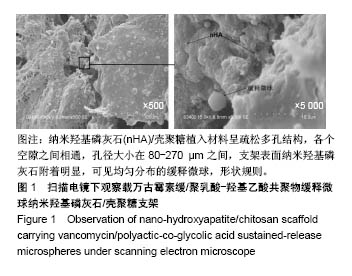

2.5.2 各组Norden评分 A-D组Norden评分分别为4.00±0.35,3.80±0.27,2.30±0.27,1.00±0.35。C、D组评分低于A、B组(P < 0.05),D组评分低于C组(P < 0.05),A、B组评分相比差异无显著性意义(P > 0.05)。结果表明载万古霉素/PLGA缓释微球纳米羟基磷灰石/壳聚糖支架移植后,对慢性骨髓炎骨缺损的修复治疗有一定效果;载万古霉素/PLGA缓释微球纳米羟基磷灰石/壳聚糖支架联合自体红骨髓后,对慢性骨髓炎骨缺损的修复治疗效果更佳。 2.5.3 各组缺损处骨组织苏木精-伊红染色 各组缺损处骨组织苏木精-伊红染色结果,见图6所示,A、B组骨小梁紊乱、破坏较多;C、D组骨小梁排列较为整齐,破坏较少,表明缺损处骨组织处于修复状态;此外D组骨小梁粗大,排列有序,表明缺损处修复效果与C组相比较佳。"

| [1] Dhanireddy S, Neme S. 44–Acute and Chronic Osteomyelitis. Infect Dis. 2017;1:388-398. [2] Winkler H, Haiden P. Treatment of Chronic Bone Infection. Oper Tech Orthop. 2016;26(1):2-11. [3] Ning L, Malmstrom H, Ren YF. Porous Collagen-Hydroxyapatite Scaffolds With Mesenchymal Stem Cells for Bone Regeneration. J Oral Implantol. 2015;41(1):45-49. [4] David F, Levingstone TJ, Schneeweiss W, et al. Enhanced bone healing using collagen–hydroxyapatite scaffold implantation in the treatment of a large multiloculated mandibular aneurysmal bone cyst in a thoroughbred filly. J Tissue Eng Regen Med. 2015;9(10):1193-1199. [5] Gomes D, Pereira M, Bettencourt AF. Osteomyelitis: an overview of antimicrobial therapy. Braz J Pharm Sci. 2013;49(1):13-27. [6] Inzana JA, Schwarz EM, Kates SL, et al. Biomaterials approaches to treating implant-associated osteomyelitis. Biomaterials. 2016;81:58-71. [7] Kaplan SL. Staphylococcus aureus Infections in Children: The Implications of Changing Trends. Pediatrics. 2016;137(4):e20160101. [8] Yang D, Wijenayaka AR, Solomon LB, et al. Novel Insights intoStaphylococcus aureusDeep Bone Infections: the Involvement of Osteocytes. MBio. 2018;9(2). pii: e00415-18.doi:10.1128/mBio. 00415-18. [9] Duszynska W, Taccone FS, Hurkacz M, et al. Continuous vs. intermittent vancomycin therapy for Gram-positive infections not caused by methicillin-resistant Staphylococcus aureus. Minerva Anestesiol. 2016;82(3):284-293. [10] Cao G, Liang X, Zhang J, et al. Vancomycin serum trough concentration vs. clinical outcome in patients with gram-positive infection: a retrospective analysis. J Clin Pharm Ther. 2016;40(6): 640-644. [11] Kadry AA, Al-Suwayeh SA, Abd-Allah AR, et al. Treatment of experimental osteomyelitis by liposomal antibiotics. J Antimicrob Chemother. 2004;54(6):1103-1108. [12] Broussou DC, Lacroix MZ, Toutain PL, et al. Differential Activity of the Combination of Vancomycin and Amikacin on Planktonic vs. Biofilm-Growing Staphylococcus aureus Bacteria in a Hollow Fiber Infection Model. Front Microbiol. 2018;9:572. [13] Marrelli M, Tatullo M. Influence of PRF in the healing of bone and gingival tissues. Clinical and histological evaluations. Eur Rev Med Pharmacol Sci. 2013;17(14):1958-1962. [14] Marrelli M, Falisi G, Apicella A, et al. Behaviour of dental pulp stem cells on different types of innovative mesoporous and nanoporous silicon scaffolds with different functionalizations of the surfaces. J Biol Regul Homeost Agents. 2015;29(4):991-997. [15] Paduano F, Marrelli M, Alom N, et al. Decellularized bone extracellular matrix and human dental pulp stem cells as a construct for bone regeneration. J Biomater Sci Polym Ed. 2017;28(8):730-748. [16] 胡荣康,吴林秀,陈明军,等.不同分子量壳聚糖的制备及其应用研究进展[J].食品工业科技,2017,38(15):324-328.[17] Boukari Y, Qutachi O, Scurr DJ, et al. A dual-application poly (dl-lactic-co-glycolic) acid (PLGA)-chitosan composite scaffold for potential use in bone tissue engineering. J Biomater Sci Polym Ed. 2017;28(16):1966-1983. [18] Shamekhi MA, Rabiee A, Mirzadeh H, et al. Fabrication and characterization of hydrothermal cross-linked chitosan porous scaffolds for cartilage tissue engineering applications. Mater Sci Eng C Mater Biol Appl. 2017;80:532-542. [19] Uswatta SP, Okeke IU, Jayasuriya AC. Injectable porous nano-hydroxyapatite/chitosan/tripolyphosphate scaffolds with improved compressive strength for bone regeneration. Mater Sci Eng C Mater Biol Appl. 2016;69:505-512. [20] Wang XF, Lu PJ, Song Y, et al. Nano hydroxyapatite particles promote osteogenesis in a three-dimensional bio-printing construct consisting of alginate/gelatin/hASCs. Rsc Adv. 2016;6(8):6832-6842. [21] Medeiros JS, Oliveira AM, de Carvalho JO, et al. Nanohydroxyapatite/ Graphene Nanoribbons Nanocomposites Induce in Vitro Osteogenesis and Promote in Vivo Bone Neoformation. Acs Biomater Sci Eng. 2018;4(5). DOI: 10.1021/acsbiomaterials.7b01032[22] Ge S, Zhao N, Wang L, et al. Bone repair by periodontal ligament stem cellseeded nanohydroxyapatite-chitosan scaffold. Int J Nanomedicine. 2012;7:5405-5414. [23] Biazar E, Heidari KS, Tavirani MR, et al. Bone reconstruction in rat calvarial defects by chitosan/hydroxyapatite nanoparticles scaffold loaded with unrestricted somatic stem cells. Artif Cells Nanomed Biotechnol. 2015;43(2):112-116. [24] 杨新明,孟宪勇,张瑛,等.带蒂筋膜瓣包裹自体红骨髓复合体修复骨缺损的疗效[J].中华创伤骨科杂志,2012,14(9):741-747.[25] 邵擎东,李宇飞,许天明,等.自体红骨髓移植治疗鼠胫骨骨不连[J].中华实验外科杂志,2015,32(6):1375-1377.[26] 向柄彦,郭元.载药微球联合BMP-2治疗兔慢性骨髓炎的实验研究[J].重庆医学,2015,44(8):1032-1034.[27] 向柄彦,郭元.载药组织工程支架的构建及其性能研究[J].现代医药卫生, 2015,31(9):1281-1282.[28] 向柄彦,韩小松,陈炎城,等.不同浓度富血小板血浆复合自体红骨髓及纳米骨治疗兔桡骨骨缺损的实验研究[J].现代预防医学, 2012,39(19): 5126-5131.[29] Li Y, Zhang Z, Zhang Z. Porous Chitosan/Nano-Hydroxyapatite Composite Scaffolds Incorporating Simvastatin-Loaded PLGA Microspheres for Bone Repair. Cells Tissues Organs. 2018;205(1):20-31. [30] Norden CW, Myerowitz RL, Keleti E. Experimental osteomyelitis due to Staphylococcus aureus or Pseudomonas aeruginosa: a radiographic- pathological correlative analysis. Br J Exp Pathol. 1980;61(4):451-460. [31] Hatzenbuehler J, Pulling TJ. Diagnosis and management of osteomyelitis. Am Fam Physician. 2011;84(9):1027-1033. [32] Bibbo C, Stough JD. Reduction calcaneoplasty and local muscle rotation flap as a salvage option for calcaneal osteomyelitis with soft tissue defect. J Foot Ankle Surg. 2012;51(3):375-378. [33] 万古霉素临床应用剂量专家组.万古霉素临床应用剂量中国专家共识[J].中华传染病杂志,2012,30(11):641-646.[34] 龙亚周,朱泽兴,于燕,等.万古霉素不同给药途径治疗慢性骨髓炎的研究进展[J].中华外科杂志,2016,54(9):716-720. |
| [1] | Zhang Tongtong, Wang Zhonghua, Wen Jie, Song Yuxin, Liu Lin. Application of three-dimensional printing model in surgical resection and reconstruction of cervical tumor [J]. Chinese Journal of Tissue Engineering Research, 2021, 25(9): 1335-1339. |
| [2] | Hou Jingying, Yu Menglei, Guo Tianzhu, Long Huibao, Wu Hao. Hypoxia preconditioning promotes bone marrow mesenchymal stem cells survival and vascularization through the activation of HIF-1α/MALAT1/VEGFA pathway [J]. Chinese Journal of Tissue Engineering Research, 2021, 25(7): 985-990. |
| [3] | Liang Xueqi, Guo Lijiao, Chen Hejie, Wu Jie, Sun Yaqi, Xing Zhikun, Zou Hailiang, Chen Xueling, Wu Xiangwei. Alveolar echinococcosis protoscolices inhibits the differentiation of bone marrow mesenchymal stem cells into fibroblasts [J]. Chinese Journal of Tissue Engineering Research, 2021, 25(7): 996-1001. |
| [4] | Geng Yao, Yin Zhiliang, Li Xingping, Xiao Dongqin, Hou Weiguang. Role of hsa-miRNA-223-3p in regulating osteogenic differentiation of human bone marrow mesenchymal stem cells [J]. Chinese Journal of Tissue Engineering Research, 2021, 25(7): 1008-1013. |
| [5] | Lun Zhigang, Jin Jing, Wang Tianyan, Li Aimin. Effect of peroxiredoxin 6 on proliferation and differentiation of bone marrow mesenchymal stem cells into neural lineage in vitro [J]. Chinese Journal of Tissue Engineering Research, 2021, 25(7): 1014-1018. |
| [6] | Zhu Xuefen, Huang Cheng, Ding Jian, Dai Yongping, Liu Yuanbing, Le Lixiang, Wang Liangliang, Yang Jiandong. Mechanism of bone marrow mesenchymal stem cells differentiation into functional neurons induced by glial cell line derived neurotrophic factor [J]. Chinese Journal of Tissue Engineering Research, 2021, 25(7): 1019-1025. |
| [7] | Pei Lili, Sun Guicai, Wang Di. Salvianolic acid B inhibits oxidative damage of bone marrow mesenchymal stem cells and promotes differentiation into cardiomyocytes [J]. Chinese Journal of Tissue Engineering Research, 2021, 25(7): 1032-1036. |
| [8] | Wang Shiqi, Zhang Jinsheng. Effects of Chinese medicine on proliferation, differentiation and aging of bone marrow mesenchymal stem cells regulating ischemia-hypoxia microenvironment [J]. Chinese Journal of Tissue Engineering Research, 2021, 25(7): 1129-1134. |
| [9] | Zeng Yanhua, Hao Yanlei. In vitro culture and purification of Schwann cells: a systematic review [J]. Chinese Journal of Tissue Engineering Research, 2021, 25(7): 1135-1141. |
| [10] | Hua Haotian, Zhao Wenyu, Zhang Lei, Bai Wenbo, Wang Xinwei. Meta-analysis of clinical efficacy and safety of antibiotic artificial bone in the treatment of chronic osteomyelitis [J]. Chinese Journal of Tissue Engineering Research, 2021, 25(6): 970-976. |
| [11] | Xu Dongzi, Zhang Ting, Ouyang Zhaolian. The global competitive situation of cardiac tissue engineering based on patent analysis [J]. Chinese Journal of Tissue Engineering Research, 2021, 25(5): 807-812. |
| [12] | Chen Junyi, Wang Ning, Peng Chengfei, Zhu Lunjing, Duan Jiangtao, Wang Ye, Bei Chaoyong. Decalcified bone matrix and lentivirus-mediated silencing of P75 neurotrophin receptor transfected bone marrow mesenchymal stem cells to construct tissue-engineered bone [J]. Chinese Journal of Tissue Engineering Research, 2021, 25(4): 510-515. |
| [13] | Wu Zijian, Hu Zhaoduan, Xie Youqiong, Wang Feng, Li Jia, Li Bocun, Cai Guowei, Peng Rui. Three-dimensional printing technology and bone tissue engineering research: literature metrology and visual analysis of research hotspots [J]. Chinese Journal of Tissue Engineering Research, 2021, 25(4): 564-569. |
| [14] | Li Li, Ma Li. Immobilization of lactase on magnetic chitosan microspheres and its effect on enzymatic properties [J]. Chinese Journal of Tissue Engineering Research, 2021, 25(4): 576-581. |
| [15] | Chang Wenliao, Zhao Jie, Sun Xiaoliang, Wang Kun, Wu Guofeng, Zhou Jian, Li Shuxiang, Sun Han. Material selection, theoretical design and biomimetic function of artificial periosteum [J]. Chinese Journal of Tissue Engineering Research, 2021, 25(4): 600-606. |
| Viewed | ||||||
|
Full text |
|
|||||
|
Abstract |
|
|||||
